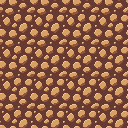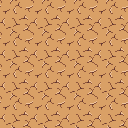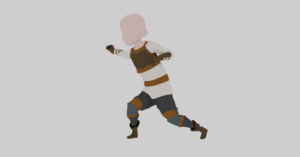Pixel art is a popular and effective art style that has been used in many classic and modern games. Despite its simplistic appearance, pixel art has a unique charm and can help create a distinctive feeling in the player of your game. In this post, we will explore the benefits of using pixel art in your game and why you should consider using it as an art style.
What is pixel art?
In order to get a better feel for Pixel art, why not have a look at a simple soil texture.


As you can see, Pixel art involves creating images using individual pixels (the squares) as the building blocks and a rather low resolution (128×128 in this case). It typically features bold colors, simple shapes (here: roundish earth parts), and a limited color palette (here: 4 colors).
Why should I use it?
Pixel art is easily recognizable and can help create a sense of nostalgia for players who grew up playing classic games. Many successful indie games have used pixel art as a means to appeal to players who are looking for a retro gaming experience. Additionally, pixel art is relatively easy and quick to create, making it a great option for solo developers or small indie teams who do not have the resources to create high-quality 3D models or complex 2D animations.
I like the ‘easy and quick’ part!
Sure! That’s what I thought as well and to top this I found that pixel art can be a great way to compensate for my lack of my overall artistic abilities. The simplistic nature of pixel art means that even beginners like me can create effective and visually appealing designs.
Okay, but what about other benefits?
Pixel art can be easily scaled and adjusted to fit different resolutions and screen sizes. This is especially important for mobile games, where the screen sizes and resolutions of different devices can vary greatly. Pixel art can also help to reduce the overall file size of your game given that pixel art mostly relies on low resolution textures/images (32×32), making it more accessible to players with slower internet speeds or limited storage space on their devices.
Let’s talk about the limited color palette!
As you are confronted with a limited set of colors, you are forced to be creative and resourceful with your choices. Instead of relying on an abundance of colors to create depth and detail, you (the artist) must use a select few colors to create the same effect. This restriction can also help maintain consistency and cohesion in the overall aesthetic of the game or project. Additionally, a limited color palette can evoke a sense of nostalgia for classic games from the past, which often had limited color capabilities due to technical limitations of the time. That said, a limited color palette can be a strength in pixel art, allowing for a unique and cohesive visual style.
Bottom Line
There are many reasons why you should consider using pixel art as an art style in your game. From its recognizable and nostalgic appeal to its scalability and ease of creation, pixel art can be a great option for indie developers or anyone looking to create a unique and visually appealing game. So, give pixel art a try and see how it can enhance the overall look and feel of your game. See you next time!
